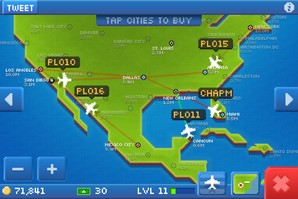
#POCKET PLANES GUIDE FULL#
Pocket Planes is a free-to-play title, which basically means it's chocked full of in-app purchases that will speed up your progression should you be feeling a little lazy. This is done, naturally, by gradually increasing the size of your fleet of birds, buying and upgrading airports across some of the worlds most popular tourist locations, and, well, increasing the size of your fleet a little bit more. You begin Pocket Planes with a handful of different aircrafts, a few airports, and one mission: create a busting and extremely profitable airline. If you've already played all three titles, you'll know that the most recent game is a darn sight trickier to get to grips with than its predecessors, simply because there are more options to alter, tweak, and fiddle with.įear not, though: Pocket Gamer has your back. This seems to be a change that was made in the 2.0 version of the game.NimbleBit, the pocket-sized development studio behind both Pocket Frogs and the equally addictive Tiny Tower, has recently released its brand-new iPhone and iPad title: Pocket Planes. If you are calculating the cost of an odd numbered slot, you must subtract 25 from the result to get the correct cost. The cost for each Plane Slot is calculated by the formula 25 ( n 4 − 16 n 3 + 96 n 2 − 216 n + 156 ), where n = the slot number. The maximum amount of plane slots is speculated to be 24,649, as that is the last one you can purchase while remaining below the new coin limit of 9,223,372,036,854,775,807 (2^63 - 1). You can only buy/build a new plane if you have a Plane Slot available. All of the parts you own are listed in the Parts menu, which also allows you to construct a plane via the build tab when you have the correct parts. In the market, parts which match those you already have are highlighted in green text as opposed to white, making it easier to find parts to complete a plane. You can purchase plane parts in the market, find them when opening a new airport, win them in global events, receive them from ad offers, or send parts between friends.Ĭrafting an airplane requires three parts - a body, controls, and an engine. Buying planes whole is usually about 20% more expensive when compared to building a plane from parts. You can complete certain global events that reward planes, you can buy the plane whole in the market tab, or you can craft planes from parts. An aircraft cannot land at an airport with a class lower than its own. A plane can land at its corresponding class and higher.

Class 3 aircraft are the largest, and can land at class 3 airports only.Ī general rule can be applied when it comes to where an aircraft can land.Class 2 aircraft can land at any class 2 or 3 airport.Class 1 aircraft are the smallest, and can land at any class of airport.The class of a plane corresponds to an Airport's class Class 3 aircraft are large work horses, meant to travel long distances and carry large amounts of cargo and people. Class 2 aircraft are a middle ground, with a few prop-driven aircraft and many jet powered planes. Class 1 aircraft are the smallest, consisting solely of prop-driven aircraft (The exception being the Kringle Cruiser). Like real aircraft, the planes in Pocket Planes also come in different classes according to the size, speed, and weight of the aircraft. Rare planes (available only through events) generally only have 1 variant, most commonly M.ĭue to their design, single seat/cargo hold planes are not available in mixed variants. There are exceptions to this some planes have only one variant, and therefore have no suffix added to their name. In some cases, seats outnumber cargo holds on mixed aircraft. The split between passengers and cargo is fixed and usually at about 50% each way.These planes carry both passengers and cargo, and are suffixed with -M.



 0 kommentar(er)
0 kommentar(er)
